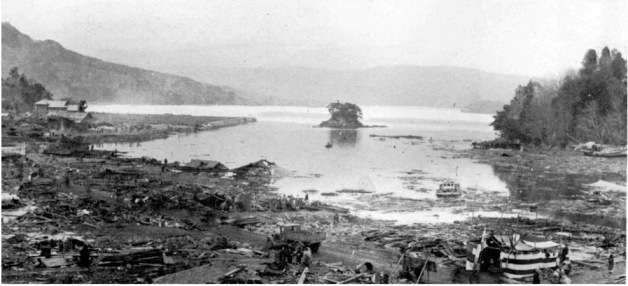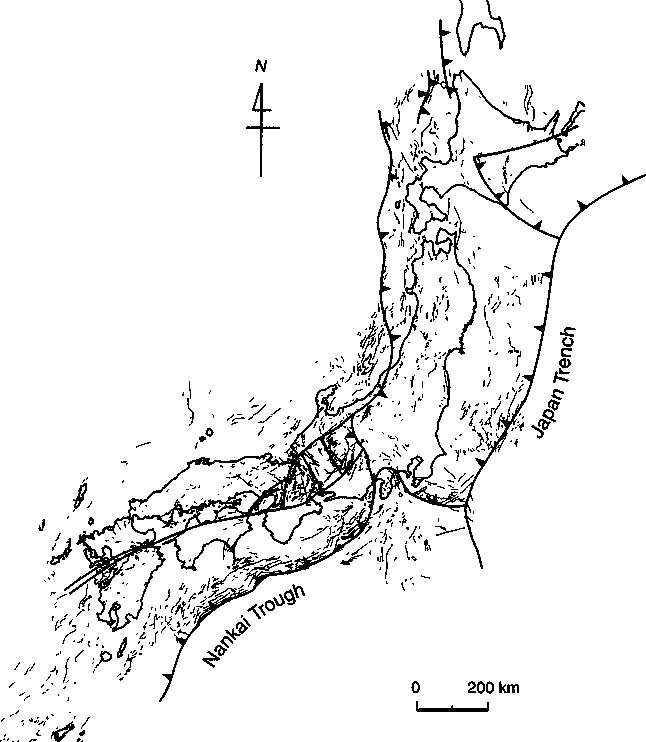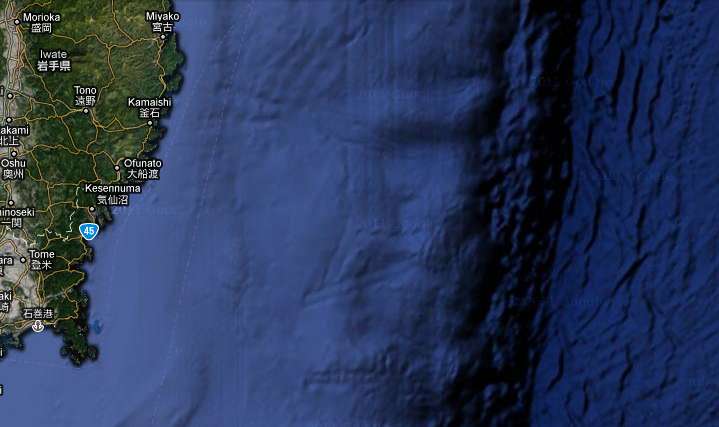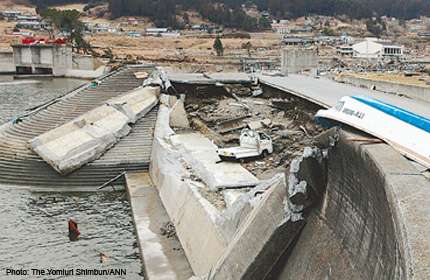Shinsaku Katayama, 85, never forgot the huge tsunami he survived in northeastern Japan in 1933. He gave classes to local elementary and middle schools, based on his experience, so that the children would be prepared for the next great tsunami. However, the government built the best sea wall in the world, so residents felt protected. Now Mr. Katayama, who survived again, is in despair, because people didn't listen to him.
Shinsaku Katayama, 85, a survivor of that tsunami who works in the construction business and lives in the area, has given lectures at primary and middle schools to increase teachers' and students' awareness of the danger of tsunami, using notes of the 1933 disaster he compiled over a one-year period.

The terse historic earthquake record compiled by the U.S. Geological Survey provides no adjectives to describe the enormity of the event Mr Katayama survived.
Historic Earthquakes
Sanriku, Japan
1933 March 02 17:31 UTC
Magnitude 8.4
3,000 deaths. Because this earthquake occurred about 290 km (180 mi) off the coast of Honshu, most of the casualties and damage were caused by the large tsunami that was generated, instead of directly from the earthquake itself. About 5,000 houses in Japan were destroyed, of which nearly 3,000 were washed away. Maximum wave heights of 28.7 m (94 ft) were observed at Ryori Bay, Honshu. The tsunami also caused slight damage in Hawaii, where a 2.9-meter (9.5-foot) was recorded at Napoopoo.
An old newsreel shows some of the devastation that happened in 1933.
The great M8.4 Sanriku earthquake of 1933 was an unusual kind of great earthquake. It took place on the Pacific plate on the Pacific ocean side of the Japan trench. In other works, it wasn't "the big one", the great subduction zone earthquake that would happen on the trench. In fact, it was an earthquake on the oceanic plate that increased the downward forces on the Pacific plate, increasing stresses on the plate boundary, advancing the time the "big one" would happen. It happened when the very old and cold Pacific plate ruptured and bent as it turned from the relatively level sea floor towards the deep trench and subduction zone. Most of the earth's sea floor is relatively warm, young and flexible. Only old and cold seafloor like the seafloor subducting into the Japan trench has "off trench" earthquakes.

A USGS report presents a brief discussion of off-trench earthquakes.
Great (M ≥ 8) off-trench normal-faulting earthquakes are rare (with 5 confirmed in the instrumental era: 1917 Tonga M~8; 1933 Japan M8.6; 1977 Banda M8.3; 2007 Kuriles M8.1; and 2009 Tonga M8.1) and their ground-motion effects usually do not affect the nearest shores because of their great distances offshore.
Their geohazard importance stems from producing large tsunamis. The plate-tectonic settings of these events share some common features: (i) All have occurred in subduction systems in which convergence rates are greater than about 65 mm/a and the incoming oceanic plate is old (Mesozoic), thermally mature, and, by inference, mechanically thick. Sea-floor bending strains and strain rates estimated from these observations are high. (ii) Large outer-rise gravity anomalies attest to high bending stresses in these source regions. (iii) Focal mechanisms indicate that the ruptures cross ocean spreading fabric at angles greater than 30 degrees and, in the two cases for which there are high-resolution swath maps available, they have fault scarps with significant relief and individual scarp lengths greater than 100 km. (iv) For those events for which seismological constraints on depth and/or focal mechanisms are available, they show that these earthquakes are very shallow normal-faulting ruptures (< 20 km below the sea floor).
These common features of great off-trench earthquakes are consistent with a model of shallow seismic deformation by large-scale bending at high stresses and strain rates. That such events occur in deep water and involve steeply-dipping (≥45°) dip-slip ruptures is consistent with the larger tsunami runups and greater damage and loss of life than are expected from megathrust earthquakes of comparable magnitude
Fragmented fault blocks in the Pacific plate are visible in the sea floor bathymetry shown on the right hand side of the Google Image of the Japan trench region.

Simulation model of a subduction zone earthquake on a fault like the plate boundary fault of the Japan trench.
This simulation shows how a subduction zone earthquake like the great 2011 earthquake, causes a tsunami. Because the 1933 earthquake had more up and down motion, it was a more efficient tsunami generator than a subduction zone earthquake. However, both types of earthquakes cause tsunamis by moving large areas of the sea floor vertically.
The 1933 Sanriku earthquake showed that a 94 foot high tsunami was possible from a smaller earthquake, further out to sea, than a main plate boundary earthquake. Clearly, a plate boundary earthquake might be able to produce a tsunami of nearly the same size. Moreover, GPS technology showed growing strain over northeastern Japan before the 2011 earthquake. Clearly the plate boundary fault was locked and storing energy that would be released in a large earthquake.
 Source: Taira, TECTONIC EVOLUTION OF THE JAPANESE ISLAND ARC SYSTEM
Source: Taira, TECTONIC EVOLUTION OF THE JAPANESE ISLAND ARC SYSTEM
However, Japanese regulators appeared to be unaware of the geologic studies and the implications of the 1933 earthquake. Although they upgraded the seismic design standards from a design basis M6.7 earthquake, they still set standards for a much smaller earthquake with much lower accelerations than would be possible in a compressional environment like northeast Japan. Thrust faults produced a peak acceleration of 1.7 times gravity in the M6.7 Northridge earthquake in the San Fernando valley of southern California, yet nowhere in Japan was the design basis acceleration for an earthquake greater than 1 times gravity.
Wikipedia: The Northridge earthquake
The Northridge earthquake occurred on January 17, 1994, at 04:31 Pacific Standard Time in Reseda, a neighborhood in the city of Los Angeles, California, lasting for about 10-20 seconds.[1] The earthquake had a "strong" moment magnitude of 6.7, but the ground acceleration was one of the highest ever instrumentally recorded in an urban area in North America,[2] measuring 1.7 g (16.7 m/s2)[3] At least 33 deaths were attributed to the earthquake, with some estimates ranging much higher, and there were over 8,700 injured. In addition, the earthquake caused an estimated $20 billion in damage, making it one of the costliest natural disasters in U.S. history.[4]
After the M7.2 Kobe earthquake in 1995 and a M7.3 earthquake in 2000 in an area with no known geologic fault the Japan Nuclear Safety Commission reassessed their regulations but still ignored the high accelerations observed in the Northridge earthquake and the large magnitude and enormous tsunami of the great 1933 Sanriku, Japan earthquake. They disregarded the seismic potential of one of the most active subduction zones on the planet, the Japan trench.
After the magnitude 7.2 Kobe earthquake in 1995 a panel was set up to review the safety of nuclear facilities in Japan and the design guidelines for their construction. The Japanese Nuclear Safety Commission (NSC) then approved the panel's report. Building and road construction standards were also thoroughly reviewed at this time. After recalculating the seismic design criteria required for a nuclear power plant to survive near the epicentre of a large earthquake the NSC concluded that under current guidelines such a plant could survive a quake of magnitude 7.75. The Kobe earthquake was 7.2.
Japan's Rokkasho reprocessing plant and associated facilities are built on stable rock and are designed to withstand an earthquake of magnitude 8.25.
Following a magnitude 7.3 earthquake in 2000 in an area where no geological fault was known, Japan's NSC ordered a full review of the country's 1978 seismic guidelines (which had been adopted by the NSC in 1981 and partially revised in 2001). This reported in 2006 and resulted in NSC and the Nuclear & Industrial Safety Agency (NISA) calling for reactor owners with NISA to undertake plant-specific reviews of seismic safety, to be completed in 2008. The main result of this review was that the S1 – S2 system was formally replaced by NSC in September 2006 with a single Design Basis Earthquake Ground Motion (DBGM Ss). The main reactor facilities "shall maintain their safety functions under the seismic force caused by DBGM Ss." They and ancillary facilities should also withstand the "seismic force loading of those caused by Elastically Dynamic Design Earthquake Ground Motion Sd (EDGM Sd)" calculated from stress analysis and being at least half the Ss figure.
In March 2008 Tepco upgraded its estimates of likely PGA for Fukushima to 600 Gal, and other operators have adopted the same figure. In October 2008 Tepco accepted 1000 Gal (1.02g) PGA as the new Ss design basis for Kashiwazaki Kariwa, following the July 2007 earthquake there.
Instead of shutting down the old Fukushima reactors which would have not been worth upgrading to higher seismic design standards, Japan's nuclear regulators approved a license extension for nuclear plants that were not designed to meet the accelerations seen in California in a M6.7 earthquake.
Instead, they upgraded standards in southern Honshu for an anticipated M8.5 earthquake. Old plants were shut down in anticipation of an earthquake on a smaller subduction zone segment than the Japan trench.
Japanese nuclear plants such as Hamaoka near Tokai are in regions where earthquakes of up to magnitude 8.5 may be expected. In fact the Tokai region has been racked by very major earthquakes about every 150 years, and it is 155 years since the last big one. Chubu's Hamaoka reactors were designed to withstand such anticipated Tokai earthquake and had design basis S1 of 450 Gal and S2 of 600 Gal. Units 3 & 4 were originally designed for 600 Gal, but the Ss standard established in September 2007 required 800 Gal. Since then units 3-5 have been upgraded to the new Ss standard of 1000 Gal. In August 2009 a magnitude 6.5 earthquake nearby automatically shut down Hamaoka 4 & 5, with ground motion of 426 Gal being recorded at unit 5. Some ancillary equipment was damaged and reactors 3 and 4 were restarted after checking. Restart of unit 5 was repeatedly deferred as the company analysed why such high seismic acceleration was recorded on it, coupled with some planned maintenance being undertaken during the shutdown. It restarted in January 2011.
Hamaoka units 1 & 2 had been shut down since 2001 and 2004 respectively, pending seismic upgrading – they were originally designed to withstand only 450 Gal. In December 2008 the company decided to write them off and build a new reactor to replace them. Modifying the two 1970s units to new seismic standards would have cost about US$ 3.3 billion and been uneconomic, so Chubu opted for a US$ 1.7 billion write-down instead.
However, the Japanese government was not unaware of the tsunami threat in northeastern Japan. They built seawalls to protect people and property from tsunamis. They even built the world's largest seawall. However, the world's largest seawall was built to reflect a far smaller tsunami than the 1933 tsunami that devastated northeastern Japan. It was big enough to protect people from distant earthquakes in Chile, but far too small to provide protection from major earthquakes in Japan. Money that could have been spent to upgrade critical facilities such as nuclear power plants was spent giving people a false sense of security.

Katayama said the number of participants in local disaster drills had fallen over the past few years and he felt awareness of the danger of tsunami had declined.
"Because of the embankments, they never imagined they'd be hit by tsunami. They acted as if nothing untoward would happen," he said with an air of despair.


